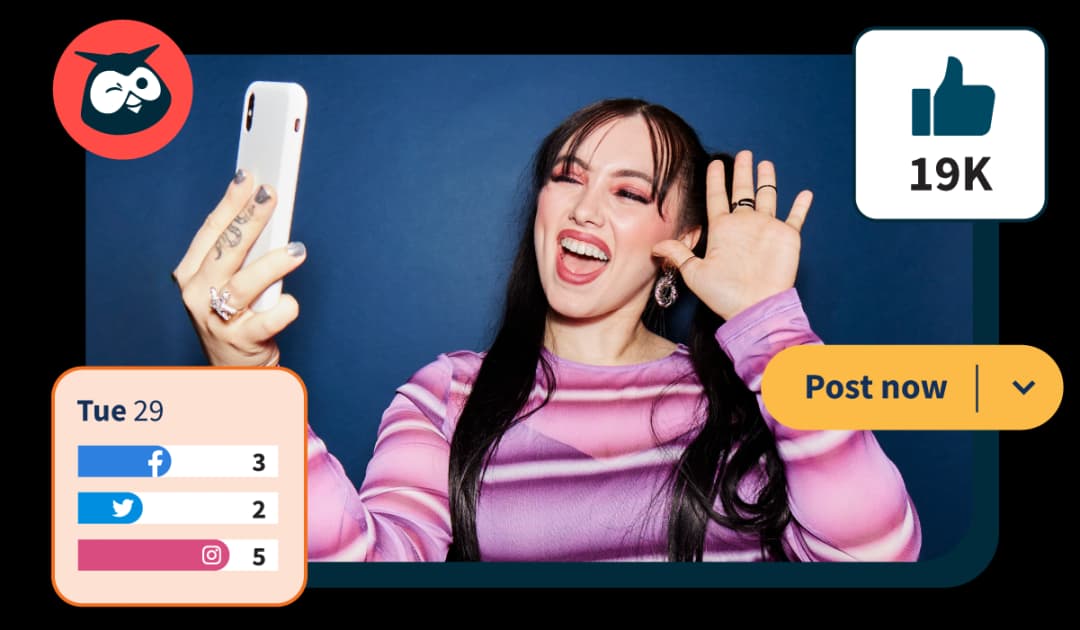
3 Benefits of Curating Content
Details
November 10, 2021
The answer: The drive to tell a story through content that will bring value to your organization.
For many, this is easier said than done. Creating engaging content is a major challenge—but it’s absolutely critical for the success of your social campaigns.
Join us for a new webinar series where we invite content and social experts to break down their best practices for producing great content.
In our first webinar, we’ll discuss the benefits of using curation to collect relevant, timely content and tell better stories.
What you’ll learn
- The difference between content curation and content creation
- Where to find content from credible sources
- How to tell better stories with the content you’ve curated
Please complete the form to register
* indicates required fields
Transcript
What is content curation?
Content curation is a proactive process of collecting, filtering, and distributing information to meet specific business goals.
Content curation is a way to provide extra value to your followers while highlighting your own industry expertise. It is a proactive process of collecting, filtering, and distributing third-party information to meet specific business goals.
Content curation has to be proactive. It's something that's done intentionally.
It involves the collection, filtering, and distribution of information.
It's more than retweeting or repurposing just user-generated content on your feed.
It's something that's used to meet specific business goals.
Whether you're trying to drive brand awareness, the top of the sales funnel, or convert people at the bottom, curation done well helps you meet those goals in specific.
Think like a librarian
Content curation done well contributes to the atmosphere we call a “brand.”
Your job as a marketer doing content curation is to think of yourself as a librarian at a really specialized library. You're curating information for your audience to build an ambiance, to keep them around, to make them stay a while and wander between the shelves as they learn new things and spend time with your brand.
Good content curation is not just reactive. Many bloggers and gurus and listicle writers talk about content curation as something that's done reactively. Many people will talk about it as something that you do to fill gaps in your content calendar or as something that's done when you don't have ideas for content yourself.
And while that is a really important, inherent benefit of it, you shouldn't be trying to plug a leaky bucket.
Content curation done well—content curation that’s done with intent and foresight—informs brand strategy and ultimately helps you deliver on these credible business goals like increasing brand awareness, driving conversions, and building trust.
And in fact, content curation might be one of the most powerful tools for marketers who are resource-strapped to really make their mark in a convoluted and noisy media landscape.
"A brand is not a logo, a brand is not a product. A brand is not a promise. A brand is the sum of all impressions that it makes on an audience. A brand is a result. It's a person's gut feeling about your product, service, or company. It's in their heads and in their hearts. A brand is your existing reputation” — Marty Neumeier
The things you say are interpreted and categorized by the people that you're speaking to. And in that vein, content curation marketing is actually a mechanism for creating a brand. It's a way of signaling what information you value and presenting it such that it creates a general impression of your business.
“Knowing where to go and what to do is the currency that, in the modern aspiration economy, makes curators more important than influencers. Curation gives even mundane objects value by connecting them with a point of view, heritage, a subculture or purpose that makes them stand out in the vortex of speed, superficiality, and newness.” — Ana Andjelic, Chief Brand Officer, Banana Republic
Inspire with user stories (like Apple)
Let’s look to a few brands to discover some of the best content curation tools and examples.
Take a big brand like Apple. Their products, particularly their laptops, have been positioned as a means to enable creativity. Especially in their Behind the Mac campaign. They've been curating stories of the people who use their products to make this message super clear. They show creators like Shawn Mendes, Justin Bieber, and Kendrick Lamar using their products.
Curation gives even mundane objects like computers value by connecting them with a point of view, a heritage, a subculture, or a purpose that makes them stand out.
Obviously not all of us have the budget to reach out to Justin Bieber. So how about a more specific and more simple example?
Create ambiance with great music (like Nike)
If you go to Spotify and search for the Nike Run Club, you'll be able to access Nike’s playlist where they've curated music that's perfect for running. This shows off their ability to know what artists are in the cultural zeitgeist while creating something of value for the people that use their products.
While I wear my Nike shoes, I can be out for a run listening to a playlist by Nike, and all of the sudden Nike is inseparable for my running routine and my identity as a runner. Curation gives even mundane objects like shoes value by connecting them with a point of view, a heritage, a subculture, or a purpose to make them stand out.
Curate experiences (like Airbnb)
And another fantastic big brand example of curation done well is Airbnb. They write city guides for travelers visiting new destinations. The content is pulled and collected from local review sites, word of mouth, and the people who use their app.
These guides are not only useful to the people who use their service, but it's also their way of creating an atmosphere for these people as they travel and go about exploring whatever city they happen to be visiting.
Content curation and social media
Social media is the obvious place to source curated content. It's the ideal place to be combing for things like relevant industry news, events, conversations happening around your industry or brand, and user-generated content that's made by people who use your product.
Social is the engine of culture. Platforms like TikTok have become an engine for the music industry to distribute and share and for consumers to pick up on whatever music's coming out. Right now, Instagram has given rise to a decade worth of fashion trends. Social media is the obvious place to look for that subculture, that heritage, that will help imbue your brand with value.
Content curation benefits
If social media is the obvious place to source and share curated content, then how does it actually benefit you, the marketer, to do so? There are three main benefits of content curation to consider.
It's really common for marketers to struggle with generating ideas for new content. According to the Marketing Insider Group…
54% of marketers struggle to create content that generates leads
52% of marketers struggle to create content that drives traffic
45% of marketers struggle to create content that resonates
34% of marketers struggle with generating ideas for content
Content curation can help improve workflow by saving time planning and making content, involving new voices and amplifying others, and plugging gaps in your content calendar.
You can compile and share content that's organically made by your audience and the people who use your product. There's also this element of involving new voices and amplifying others. Say you're a company selling boutique makeup supplies, you can start partnering with creators to do unboxings and reviews of your product.
Amplifying others is also a great way to show your position on something as a brand and latching onto powerful cultural moments when it's appropriate to do so. Say your makeup company is very focused on something like creating sustainable products. It wouldn't be out of place for you to share and amplify fundraisers for climate change, but ultimately sharing the right content lets you take a position and show off some of the values that you hold as an organization.
And the third element is plugging gaps in your content calendar. We all know that keeping a constant flow of content is not easy. The truth is that posting consistently is much more important than finding the perfect time. So whether it's once a week or once a day, posting consistently is what's most important when it comes to satisfying social media algorithms and keeping your audience engaged constantly.
For the days or weeks or months when you're low on content ideas, content curation is a nice way to give yourself a backlog of stuff to share when you're not quite sure what to post. And trust me, we've all been there.
Content curation is also a phenomenal way to get yourself noticed—not just with the people you're sharing content with, but also the people whose content you're sharing. It helps you build a network. Here are three ways it does this:
Keep an ongoing conversation with your audience
Connect with experts
Become the go-to source
Content curation helps you keep an ongoing conversation with your audience. So many brands actually make the mistake of treating social media like a one-way channel, sharing press releases, that sort of thing. And they end up talking at their audience rather than engaging them earnestly. Curating content from your audience is a great way to start genuinely engaging and commenting on things that your customers are doing.
Depending on your industry, there's more likely than not someone or many people online with expertise in the product or service that you sell. For makeup brands, it's people who review makeup online. For bookstores, it's book bloggers and reviewers, and people who are engaging in these conversations. For something like a neighborhood restaurant, it's people who review and talk about food online.
Partner with these people and tap into them as a recurring source of content and establish a reputation so that you can establish a reputation with their audience as well as yours. There's also this element of becoming the go-to source. Depending on whatever niche of the market you serve, you can use content curation to become the go-to source of information on a given subject.
For nimble organizations who pride themselves in doing things on a shoestring, content curation can help you understand your customers and market better. And ultimately, curation done well can not only be a way to execute on your communication strategy, but also to inform it.
How to use content curation for research:
Learn more about your audience
Learn more about your market
Make business decisions with insight
You can use content curation to learn more about your audience. If you're curating content that's coming from your audience on social media, take the opportunity to pay attention to patterns and trends in what's being spoken about and said. As you're curating, you can assess different streams of argument, isolate pain points, and figure out where there might be gaps between what you are saying and what your audience wants to hear.
You can also take it as an opportunity to learn more about your market. If you're curating content from your competitors or from influencers and experts, you might start to pick up on trends and themes that could help you make product development decisions or inspire new ways of working. It's all about making business decisions with insight.
And ultimately the goal is to use curation as a means of getting real-time insight into the people that you're selling to so that you can make clear and better-informed business decisions.
Content curation techniques and ideas
And now let's spend a little bit of time talking about how to actually use content curation to tell better stories.
Using social media to curate content from third-party sources is one thing, but there's something creative in flipping the magnifying glass back on yourself and curating content in your past into a series.
Brands like Gucci are doing this incredibly well using Instagram Guides. They'll take archival photos, photos from runway events, awards shows, and street fashion and curate them retroactively into a theme post. They can then turn that guide into content for resharing over things like Stories or distributing on their other feeds as a standalone asset. And this strategy is really powerful.
Maybe you've been active on Instagram for a while and have a treasure trove of content to pull from. You don't always have to look externally for a new story to tell. Sometimes you can look back at what you've already done and curate new stories out of old or existing content.
I actually firmly believe that our job as marketers isn't to convince people of the value of our products. Our customers are smarter than we often give them credit for it. They can make decisions for themselves.
Our job as marketers is to help people make informed decisions with the best possible information. Which means that it is our job as marketers to make sure that people have the best possible information at their disposal at all times. And that's where curation comes in.
This is an example of a newsletter from It's Nice That. They take content off of their social media feeds and curate industry news and events and education into a newsletter. You don't have to be writing these pieces yourself. You don't have to be hosting the events yourself. But pull things that you find on social, off the feed and into a well-packaged piece.
Show fans and followers that they can be trusted as a source of inspiration and information. It would also keep them accountable to keeping up with the fast-paced and quickly moving industries like commercial creative and advertising.
“It is not hard to see how this crowded cultural landscape can lead to the consumer choice overload, and why curation gained prominence as the obvious way out of it. The role of a curator is to sort through culture and show us what we need to know and why.” — Ana Andjelic
In order to stand out in an increasingly crowded information landscape, marketers should position themselves not as the primary creators of new information, but as the people who decide what's worth paying attention to.
Curation has the potential to create a positive feedback loop. If people rely on your brand to share their content consistently, and see it as a means of getting themselves noticed, they will actively go out of their way to create content that meets your brand aesthetic.
Take the activewear outdoors equipment company Polar. They've consistently reshared so much content from their followers that many people in the outdoor community will actively tag them when they want their own content shared, which reinforces their brand aesthetic, which reinforces customer participation, which reinforces the brand aesthetic, and so on and so on.
Building a strong atmosphere with your curated content is a way of organically reinforcing your brand.
Content Curation Q&A
Q. Do you have any suggestions on the type of content that works for a company that's not selling a product?
A. Think about anchoring content curation to the goals of your brand or your organization. Think about building that atmosphere so that people have almost a sensory memory of interacting with your organization on social so that when they leave, they're still thinking about it or when they think about your brand weeks later, they remember this feeling that you conveyed, whether that was through sound or visuals or videos or the stories that you're telling.
Q. How would you curate content to start conversations specifically on LinkedIn? We find it very difficult to get the conversation going on this platform.
A. My biggest tip for LinkedIn would be remembering why people use the platform. People are on LinkedIn to present themselves as professionals and to curate themselves. So any type of content that encourages people to jump into the conversation, to add their opinion, to present themselves the way they want to present themselves, would help boost engagement. Asking for people's opinions, asking for insight. When you put the call out for insight like that, people on LinkedIn are happy to throw plenty of comments your way.
Q. How would you approach content curation for a B2B brand?
A. Use content curation not as a way to fill up your own feed, but as a research tool. I think when it comes to B2B businesses, try to discover more about what the specific needs of your customers are. There's something really powerful that can be done when you're collecting that information.
Q. How would you handle sharing content from clients or industry partners and preventing showing preference for certain clients?
A. I think one way you could go about it diplomatically, if you will, is by always including a callout when you share something. If you are showcasing a client’s content, add a line that says, "Do you have something that you think would be great for us to share? Send it our way.” Anything that shows that you are open to sharing anyone and everyone's content — and not just specific people’s — is a good way get more of the content you're looking for and show that you’re not playing favorites.
Q. What's the difference between a curator and an influencer?
A. An influencer to me is just anybody who has a level of expertise or an audience to be speaking to online. So it could be Noah Beck from TikTok or it could be a local person who reviews books for a small bookstore or in a small town. So anybody like that, to me, with an audience and a reputation already existing online is an "influencer." And a curator is somebody who collects that content from various places and redistributes it and shares it. Could somebody become an influencer through curation? Absolutely. And I think that's one of the goals here.
Q. How do you maintain a specific atmosphere when your company has different streams? For example, a mall with different retailers and attractions.
A. I think even a mall with different brands should still have its own umbrella branding, right? Because that is how you choose what stores go into the mall, right? What type of foot traffic you're trying to attract, who your highest-paying visitors are. Narrowing in on that ideal audience, the ideal mall visitor from a broader marketing and branding perspective, I think can really help you curate the content on social for that specific subset of people.
You can't be all things to all people, you just can't. But by choosing your most aspirational visitors, your most aspirational audience, and curating the atmosphere for them, it should hopefully encompass and not contradict all of the other kinds of sub-brands that you have underneath.
Q. Would you say quality over quantity and consistency over too much posting is key for social?
A. You have to make sure that every post has quality behind it and is intentional and is serving some kind of a purpose. And that's what's ultimately going to drive credible engagement. It's one thing to have 1,000 followers who don't engage with your content because there's inconsistency or not all of it's useful. It's another thing to have 35 very dedicated followers, obviously depending on your business, who will constantly share, constantly engage, and constantly be interested in what you have to say. And my opinion is that the latter is more powerful for businesses. So yes, quality over quantity all the time, every time.
It used to be that the algorithms weren't at play as much and it really mattered that you were posting when people would see it. Now that feeds are arranged a lot more algorithmically, things are based more on relationships and engagement and previous interactions. And especially now that paid social is so prevalent and so effective. Quality, I think, takes the cake because of that. Because that is really what's going to get your content engaged with more and get all of the little things that the algorithm uses to prioritize it. Quality is what's going to attract those attributes.
Q. Should we use curation for all of our channels regardless of how strong our presence is on each platform?
A. I think you actually have an advantage if you're starting with a smaller following because you can build up your audience in exactly the way you want to. So if you have a small base, think of that as an opportunity. Think of it as the opportunity to be like, "Okay, we don't have a big presence right now. Who exactly do we want to attract? And how can curating content and building that atmosphere on Instagram help us attract those exact people?" I would see it as an opportunity and not a place of weakness.
Speaker
Related resources
3 Benefits of Curating Content
What do all social media managers have in common?
Interested in learning more with Hootsuite?
Request a demo


